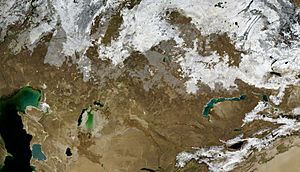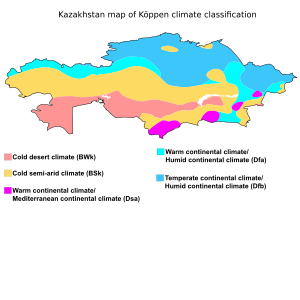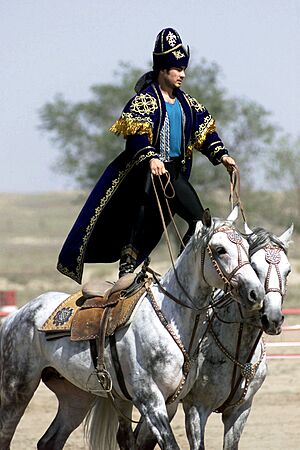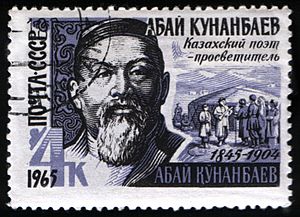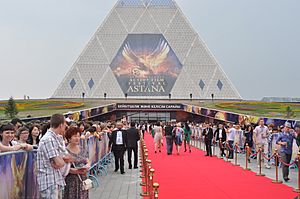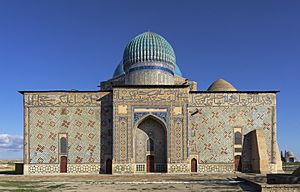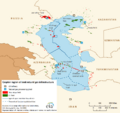Kazakhstan facts for kids
Quick facts for kids
Republic of Kazakhstan
|
|
|---|---|
|
|
|
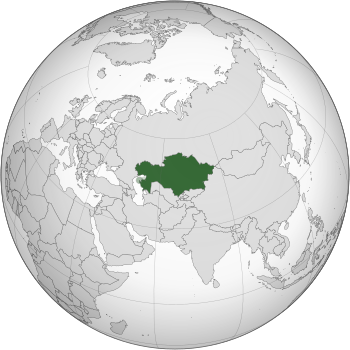 |
|
| Capital | Astana 51°10′N 71°26′E / 51.167°N 71.433°E |
| Largest city | Almaty 43°16′39″N 76°53′45″E / 43.27750°N 76.89583°E |
| Official languages | |
| Ethnic groups
(2024)
|
|
| Religion
(2021)
|
|
| Demonym(s) | Kazakh Kazakhstani |
| Government | Unitary semi-presidential republic under an authoritarian government |
| Kassym-Jomart Tokayev | |
| Oljas Bektenov | |
| Legislature | Parliament |
| Senate | |
| Majilis | |
| Formation | |
| 1465 | |
|
• Alash Autonomy
|
13 December 1917 |
|
• Kirghiz ASSR
|
26 August 1920 |
|
• Kazakh ASSR
|
19 June 1925 |
|
• Kazakh SSR
|
5 December 1936 |
|
• Declaration of sovereignty
|
25 October 1990 |
|
• Reconstituted as the Republic of Kazakhstan
|
10 December 1991 |
|
• Independence from the USSR
|
16 December 1991 |
| 26 December 1991 | |
|
• Current constitution
|
30 August 1995 |
| Area | |
|
• Total
|
2,724,900 km2 (1,052,100 sq mi) (9th) |
|
• Water (%)
|
1.7 |
| Population | |
|
• 2024 estimate
|
20,075,271 (62nd) |
|
• Density
|
7/km2 (18.1/sq mi) (236th) |
| GDP (PPP) | 2024 estimate |
|
• Total
|
|
|
• Per capita
|
|
| GDP (nominal) | 2024 estimate |
|
• Total
|
|
|
• Per capita
|
|
| Gini (2018) | ▲ 27.8 low |
| HDI (2022) | very high · 67th |
| Currency | Tenge (₸) (KZT) |
| Time zone | UTC+5 (West / East) |
| Driving side | right |
| ISO 3166 code | KZ |
| Internet TLD |
|
Kazakhstan is a large country in the middle of Eurasia, which is the combined landmass of Europe and Asia. Its official name is the Republic of Kazakhstan. It is the ninth biggest country in the world. It is also the largest landlocked country, meaning it has no direct access to an ocean. Before the Soviet Union ended, it was known as the "Kazakh Soviet Socialist Republic". Astana is the capital city of Kazakhstan. Before 1998, Almaty was the capital.
The Kazakh language is the main language, but Russian is also an official language for government and public use. About 70% of the people in Kazakhstan follow Islam, while 26% practice Christianity. Russia rents land from Kazakhstan for the Baikonur Cosmodrome, which is a famous site for launching spacecraft.
Contents
What's in a Name?
The English word Kazakh comes from the Russian word "казах". The local name is "қазақ" (qazaq). This name might come from a Turkic word meaning 'to wander'. This makes sense because the Kazakh people used to be nomads, moving from place to place. The word 'Cossack' has the same origin.
The term Özbek-Qazaq was first used in the mid-1500s. It appeared in a book called Tarikh-i-Rashidi. The word Kazakh traditionally meant only ethnic Kazakhs. This included those living in other countries like China, Russia, and Uzbekistan. However, now it is often used to mean any person living in Kazakhstan, no matter their background.
Kazakhstan's Geography
Kazakhstan is unique because it has land in both Europe and Asia. The Ural River is seen as the border between these two continents. This makes Kazakhstan one of only two landlocked countries that are on two continents. The other country is Azerbaijan.
Kazakhstan is huge, covering about 2.7 million square kilometers. This is about the size of Western Europe. It is the ninth-largest country and the biggest landlocked country in the world. Kazakhstan shares long borders with Russia, Uzbekistan, China, Kyrgyzstan, and Turkmenistan.
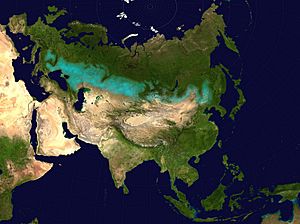
Major cities include Astana, Almaty, Qarağandy, Şymkent, Atyrau, and Öskemen. The country stretches from the Caspian Sea in the west to the Altay Mountains in the east. In the north, it reaches the plains of Siberia, and in the south, the deserts of Central Asia.
A large part of Kazakhstan is covered by the Kazakh Steppe. This is the world's largest dry plain, covering about one-third of the country. It has vast areas of grasslands and sandy regions. Important bodies of water include Lake Balkhash and Lake Zaysan. Rivers like the Charyn, Ili, Irtysh, Ishim, Ural, and Syr Darya flow through the country. The Aral Sea used to be a major sea, but it has mostly dried up.
The Charyn Canyon is a stunning natural wonder. It is 80 kilometers long and cuts through a red sandstone plateau. Its steep slopes and arches can reach heights of 150 to 300 meters. This canyon was a safe place for a rare ash tree called Fraxinus sogdiana during the Ice Age. Kazakhstan's Almaty region also has the Mynzhylky mountain plateau.
Natural Resources and Economy
Kazakhstan has many valuable natural resources, especially minerals and fossil fuels. These resources, like oil, natural gas, and various minerals, have attracted a lot of money from other countries. They make up a big part of Kazakhstan's economy.
Kazakhstan is believed to have the second-largest reserves of uranium, chromium, lead, and zinc. It also has the third-largest manganese reserves and the fifth-largest copper reserves. The country is also rich in coal, iron, and gold. It even exports diamonds. Most importantly for its economy, Kazakhstan has the 11th largest known reserves of both oil and natural gas.
There are many oil deposits, with billions of tons of oil. However, Kazakhstan only has three refineries to process this oil. So, much of the crude oil is sent to Russia. In 2009, Kazakhstan was producing about 1.5 million barrels of oil every day.
Kazakhstan also has large amounts of phosphorite, which is used to make fertilizers. The country is recognized for being open about its natural resource earnings. This means they share information about how much money they make from these resources.
Climate and Weather
Kazakhstan has an "extreme" continental climate. This means it has very hot summers and very cold winters. In fact, Astana is the second coldest capital city in the world, after Ulaanbaatar in Mongolia. The country generally has dry or semi-dry conditions, especially in winter.
| Location | July (°C) | July (°F) | January (°C) | January (°F) |
|---|---|---|---|---|
| Almaty | 30/18 | 86/64 | 0/−8 | 33/17 |
| Şymkent | 32/17 | 91/66 | 4/−4 | 39/23 |
| Qarağandy | 27/14 | 80/57 | −8/−17 | 16/1 |
| Astana | 27/15 | 80/59 | −10/−18 | 14/−1 |
| Pavlodar | 28/15 | 82/59 | −11/−20 | 12/−5 |
| Aqtobe | 30/15 | 86/61 | −8/−16 | 17/2 |
Wildlife and Nature
Kazakhstan has ten nature reserves and ten national parks. These places protect many rare and endangered plants and animals.
Common plants include Astragalus and Allium. Some endangered plant species are native wild apple, wild grape, and several types of wild tulip.
Common mammals found here are the wolf, red fox, corsac fox, and moose. You can also find the argali (the largest type of sheep), Eurasian lynx, Pallas's cat, and snow leopards. Many of these animals are protected. Kazakhstan's Red Book of Protected Species lists 125 types of animals and 404 types of plants, including fungi and algae.
How Kazakhstan is Governed
Kazakhstan is divided into seventeen regions. It also has three special cities: Almaty, Astana, and Şymkent. These cities are independent of the regions they are in. The regions are further divided into 177 districts. These districts then have smaller rural areas and villages.
The cities of Almaty and Astana are called "cities of state importance." This means they have the same level of importance as a region. The city of Baikonur has a special status too. Russia rents it until 2050 for the Baikonur Cosmodrome, which is a space launch site. In 2018, Şymkent also became a "city of republican significance."
Each region is led by an äkim, or regional governor. The president of Kazakhstan appoints these governors. The capital of Kazakhstan was moved from Almaty to Astana on December 10, 1997.
Major Cities
|
Largest cities or towns in Kazakhstan
|
||
|---|---|---|
| Rank | Name | Pop. |
| 1 | Almaty | 1,854,656 |
| 2 | Astana | 1,078,384 |
| 3 | Şymkent | 1,009,086 |
| 4 | Qarağandy | 497,712 |
| 5 | Aqtobe | 487,994 |
| 6 | Taraz | 357,791 |
| 7 | Pavlodar | 333,989 |
| 8 | Öskemen | 331,614 |
| 9 | Semey | 323,138 |
| 10 | Atyrau | 269,720 |
Population of Kazakhstan
The population of Kazakhstan is estimated to be over 20 million people as of November 2023. In 2013, the population grew to 17.28 million, showing a 1.7% increase from the previous year.
The population had decreased after 1989 but has since started to grow again. Women make up slightly more than half of the population (51.7%), while men make up 48.3%.
Kazakh Culture
Before Russia took control, the Kazakh people had a rich culture. It was based on their life as nomadic herders. Islam arrived in the region in the 8th century with the Arabs. It spread from the south to the north. Later, the Golden Horde also helped spread Islam in the 14th century.
Kazakhstan has produced many important people in literature, science, and philosophy. Some famous names include Abay Qunanbayuli, Mukhtar Auezov, and Kanysh Satpayev.
Tourism is growing fast in Kazakhstan. The country is now part of international tourism groups. It connects with countries in South Asia, Central Asia, and Eastern Europe for tourism.
Literature and Storytelling
Kazakh literature includes both spoken stories and written works in the Kazakh language. It covers the history of the Kazakh people, from ancient times to the present. There are also stories from other Turkic tribes who lived in Kazakhstan.
Chinese writings from the 6th to 8th centuries show that Turkic tribes in Kazakhstan had a tradition of oral poetry. These stories were passed down by bards. Bards were professional storytellers and musicians. Kazakh bards were usually men. They were divided into two main types:
- Zhıraws: These bards shared the works of others and usually did not create their own.
- Aqyns: These bards made up their own poems, stories, or songs on the spot.
There were different kinds of works, like teaching poems, sad poems, and long epic stories. Many of these stories were linked to bards from the past. They were first written down in the late 1800s. Some famous epic tales include Er Targhın and Alpamıs. The Book of Dede Korkut and Oguz Name are well-known Turkic heroic legends. They were first created around the 9th century and passed down orally for generations.
Abai Qunanbaiuly (1845–1904) was very important for modern Kazakh literature. His writings helped preserve Kazakh folk culture. Abai's main work is The Book of Words. It is a collection of poems and thoughts where he encouraged Kazakhs to get an education.
Music and Sounds
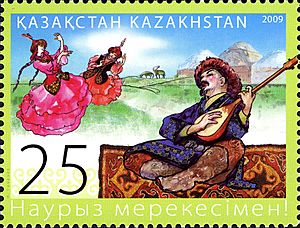
Modern Kazakhstan has several important music groups. These include the Kazakh State Kurmangazy Orchestra of Folk Instruments and the Kazakh National Opera. The folk instrument orchestra is named after Kurmangazy Sagyrbayuly, a famous composer from the 1800s. The first music school for higher education was founded in 1931.
Traditional Kazakh music has two main types:
- Instrumental music: Pieces called "Küy" are played by solo musicians. The music often tells a story.
- Vocal music: This is sung during ceremonies like weddings or feasts. It includes epic singing about history, love songs, and teaching verses. A special form is "Aitys," where two or more singers have a public musical debate.

Russian influence changed music in Kazakhstan. European music was introduced through concert halls and music schools. Kazakh traditional music was also adapted into these academic styles. Before the 20th century, researchers studied and wrote down Kazakh folk music. Some composers used Kazakh folk songs in their European classical music.
Kazakhs themselves did not write down their music until 1931. During the Soviet era, Kazakh folk culture was encouraged, but in a way that avoided political problems. This led to a simpler version of real Kazakh folk music. A Russian official named Aleksandr Zatayevich created art music using Kazakh folk melodies. He also changed traditional Kazakh instruments for use in Russian-style orchestras.
Fine Arts and Creativity
Fine arts in Kazakhstan, like painting and sculpture, started in the late 1800s and early 1900s. Russian artists like Vasily Vereshchagin and Nikolai Khludov greatly influenced it. Khludov taught many local artists, including the famous Abilkhan Kasteyev. The State Museum of Art of Kazakhstan is named after Kasteyev.
The Kazakh school of fine arts fully developed by the 1940s and grew strong in the 1950s. Local painters, graphic artists, and sculptors were trained in the Soviet system. They often used Kazakh themes in their art. Key figures in Kazakhstani art today include painters O. Tansykbaev and K. Telzhanov, and sculptors H. Nauryzbaeva.
Delicious Cuisine
Kazakh national cuisine often features horse meat and beef. These meats are cooked in many ways and served with different traditional breads. For drinks, people often have black tea with milk and dried fruits. In southern areas, green tea is popular. Traditional milk drinks include ayran, shubat, and kymyz. A traditional Kazakh dinner starts with many appetizers. Then comes a soup, followed by one or two main dishes like pilaf and beshbarmak. They also drink kumys, which is fermented mare's milk.
Sports and Games
Kazakhstan does very well in Olympic sports, especially boxing. This has brought attention to the country's athletes. Dmitry Karpov is a famous decathlete who won bronze medals in the Olympics and World Championships. Olga Rypakova is an athlete who specializes in triple jump (women's). She won a silver medal in 2011 and a gold medal in the 2012 Summer Olympics.
Kazakhstan's city of Almaty tried to host the Winter Olympic Games twice. Astana and Almaty hosted the 2011 Asian Winter Games. Popular sports in Kazakhstan include football, basketball, ice hockey, bandy, and boxing.
Football is the most popular sport. The Football Federation of Kazakhstan manages the men's, women's, and futsal national teams.
Alzhan Zharmukhamedov was Kazakhstan's most famous basketball player. He played for the Soviet Union's national team in the 1960s and 1970s. The Kazakhstan's national basketball team was formed in 1992. They won a bronze medal at the 2002 Asian Games.
The Kazakhstan national bandy team is one of the best in the world. They have won bronze medals many times at the Bandy World Championship. They also won the first bandy tournament at the Asian Winter Games.

The Kazakhstan men's national ice hockey team has competed in the ice hockey Winter Olympics in 1998 and 2006. The Kazakhstan Hockey Championship has been held since 1992. Barys Astana is the main professional ice hockey team. Top Kazakhstani ice hockey players include Nik Antropov and Evgeni Nabokov.
Kazakh boxers are very well known. In recent Olympic Games, they have won many medals, often more than any other country except Cuba and Russia. Three Kazakhstani boxers have won the Val Barker Trophy for best boxer at the Olympics. These include Vassiliy Jirov (1996), Bakhtiyar Artayev (2004), and Serik Sapiyev (2012). In the 2000 Summer Olympics, two Kazakh boxers won gold medals: Bekzat Sattarkhanov and Yermakhan Ibraimov. Two others won silver medals. Gennady Golovkin is a famous Kazakh boxer who holds several middleweight titles.
Film and Movies
Kazakhstan's film industry is run by the state-owned Kazakhfilm studios in Almaty. This studio has made award-winning movies like Myn Bala and Harmony Lessons. Kazakhstan hosts two film festivals every year: the International Astana Action Film Festival and the Eurasia International Film Festival. Hollywood director Timur Bekmambetov is from Kazakhstan. He helps connect Hollywood with the Kazakh film industry.
A Kazakh journalist, Artur Platonov, won an award for his documentary "Sold Souls" in 2013. The film was about Kazakhstan's efforts against terrorism.
Media and News
Kazakhstan is ranked 161 out of 180 countries for press freedom by Reporters Without Borders. In 2002, a court ordered a newspaper called Respublika to stop printing. The newspaper found ways to keep printing under different names. Human Rights Watch said this showed how far Kazakh authorities would go to silence critical media.
An organization called the American Bar Association Rule of Law Initiative opened a media support center in Almaty. This center helps news outlets in Kazakhstan.
UNESCO World Heritage Sites
Kazakhstan has five sites listed by UNESCO as World Heritage sites. Three are cultural sites and two are natural sites.
The cultural sites are:
- Mausoleum of Khoja Ahmed Yassaui, added in 2003.
- Petroglyphs (ancient rock carvings) within the Archaeological Landscape of Tamgaly, added in 2004.
- Silk Roads: the Routes Network of Chang'an-Tianshan Corridor, added in 2014.
The natural sites are:
- Saryarka - Steppe and Lakes of Northern Kazakhstan, added in 2008.
- Western Tien Shan, added in 2016.
Images for kids
-
Approximate extent of Scythia in the 1st century BC
-
Cuman–Kipchak confederation in Eurasia circa 1200. The Kazakhs are descendants of Kipchaks, Nogais and other Turkic and medieval Mongol tribes
-
Ural Cossacks skirmish with Kazakhs (the Russians originally called the Kazakhs "Kirgiz")
-
Downtown Astana
-
Aktau is Kazakhstan's only seaport on the Caspian Sea
-
Baikonur Cosmodrome is the world's oldest and largest operational spaceport
-
Population pyramid, 2020
See also
 In Spanish: Kazajistán para niños
In Spanish: Kazajistán para niños




